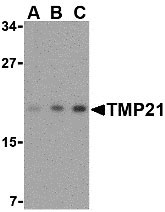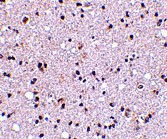TMP21 Antibody
- 产品详情
- 实验流程
- 背景知识
Application
| WB, E, IHC-P |
|---|---|
| Primary Accession | P49755 |
| Other Accession | AAD31941, 4885697 |
| Reactivity | Human, Mouse, Rat |
| Host | Rabbit |
| Clonality | Polyclonal |
| Isotype | IgG |
| Calculated MW | 24976 Da |
| Concentration (mg/ml) | 1 mg/mL |
| Conjugate | Unconjugated |
| Application Notes | TMP21 antibody can be used for detection of TMP21 by Western blot at 0.5 - 2 µg/mL. Antibody can also be used for immunohistochemistry starting at 5 µg/mL. |
| Gene ID | 10972 |
|---|---|
| Other Names | TMP21 Antibody: p23, TMP21, S31I125, Tmp-21-I, S31III125, P24(DELTA), Transmembrane emp24 domain-containing protein 10, 21 kDa transmembrane-trafficking protein, transmembrane emp24-like trafficking protein 10 (yeast) |
| Target/Specificity | TMED10; |
| Reconstitution & Storage | TMP21 antibody can be stored at 4℃ for three months and -20℃, stable for up to one year. As with all antibodies care should be taken to avoid repeated freeze thaw cycles. Antibodies should not be exposed to prolonged high temperatures. |
| Precautions | TMP21 Antibody is for research use only and not for use in diagnostic or therapeutic procedures. |
| Name | TMED10 (HGNC:16998) |
|---|---|
| Synonyms | TMP21 |
| Function | Cargo receptor involved in protein vesicular trafficking and quality control in the endoplasmic reticulum (ER) and Golgi (PubMed:10052452, PubMed:11726511, PubMed:16641999, PubMed:17288597, PubMed:19296914, PubMed:20427317, PubMed:21219331, PubMed:27569046). The p24 protein family is a group of transmembrane proteins that bind coat protein complex I/COPI and coat protein complex II/COPII involved in vesicular trafficking between the membranes (PubMed:10052452). Acts at the lumenal side for incorporation of secretory cargo molecules into transport vesicles and involved in vesicle coat formation at the cytoplasmic side (PubMed:20427317, PubMed:27569046). Mainly functions in the early secretory pathway and cycles between the ER, ER-Golgi intermediate compartment (ERGIC) and Golgi, mediating cargo transport through COPI and COPII-coated vesicles (PubMed:10052452, PubMed:10852829, PubMed:12237308). In COPII vesicle-mediated anterograde transport, involved in the transport of GPI-anchored proteins by acting together with TMED2 as their cargo receptor; the function specifically implies SEC24C and SEC24D of the COPII vesicle coat and lipid raft-like microdomains of the ER (PubMed:20427317, PubMed:27569046). Recognizes GPI anchors structural remodeled in the ER by the GPI inositol-deacylase/PGAP1 and the metallophosphoesterase MPPE1/PGAP5 (By similarity). In COPI vesicle-mediated retrograde transport, involved in the biogenesis of COPI vesicles and vesicle coat recruitment (PubMed:11726511). Involved in trafficking of amyloid beta A4 protein and soluble APP-beta release (independent from the modulation of gamma-secretase activity) (PubMed:17288597). Involved in the KDELR2-mediated retrograde transport of the toxin A subunit (CTX-A- K63)together with COPI and the COOH terminus of KDELR2 (By similarity). On Golgi membranes, acts as a primary receptor for ARF1-GDP, a GTP- binding protein involved in COPI-vesicle formation (PubMed:11726511). Increases coatomer-dependent GTPase-activating activity of ARFGAP2 which mediates the hydrolysis of ARF1-bound GTP and therefore modulates protein trafficking from the Golgi apparatus (PubMed:19296914). Involved in the exocytic trafficking of G protein-coupled receptors F2LR1/PAR2 (trypsin and tryspin-like enzyme receptor), OPRM1 (opioid receptor) and P2RY4 (UTD and UDP receptor) from the Golgi to the plasma membrane, thus contributing to receptor resensitization (PubMed:21219331). In addition to its cargo receptor activity, may also act as a protein channel after oligomerization, facilitating the post- translational entry of leaderless cytoplasmic cargo into the ERGIC (PubMed:32272059). Involved in the translocation into ERGIC, the vesicle entry and the secretion of leaderless cargos (lacking the secretion signal sequence), including the mature form of interleukin 1/IL-1 family members, the alpha-crystallin B chain HSPB5, the carbohydrate-binding proteins galectin-1/LGALS1 and galectin-3/LGALS3, the microtubule-associated protein Tau/MAPT, and the annexin A1/ANXA1; the translocation process is dependent on cargo protein unfolding and enhanced by chaperones HSP90AB1 and HSP90B1/GRP9 (PubMed:32272059). Could also associates with the presenilin-dependent gamma-secretase complex in order to regulate gamma-cleavages of the amyloid beta A4 protein to yield amyloid-beta 40/Abeta40 (PubMed:16641999). |
| Cellular Location | Endoplasmic reticulum membrane; Single-pass type I membrane protein. Endoplasmic reticulum-Golgi intermediate compartment membrane; Single-pass type I membrane protein. Golgi apparatus membrane; Single-pass type I membrane protein. Golgi apparatus, cis-Golgi network membrane; Single-pass type I membrane protein. Golgi apparatus, trans-Golgi network membrane {ECO:0000250|UniProtKB:Q63584}; Single-pass type I membrane protein. Cytoplasmic vesicle, secretory vesicle membrane; Single-pass type I membrane protein. Cell membrane {ECO:0000250|UniProtKB:Q63584}; Single-pass type I membrane protein. Melanosome Note=Identified by mass spectrometry in melanosome fractions from stage I to stage IV. |
For Research Use Only. Not For Use In Diagnostic Procedures.
Provided below are standard protocols that you may find useful for product applications.
BACKGROUND
TMP21 Antibody: TMP21 is a ubiquitously expressed protein that is involved in vesicular targeting and protein transport. More recent experiments have shown that it is also a component in the presenilin complex and modulates the gamma-secretase but not the epsilon-secretase cleavage activity of the amyloid precursor protein. The presenilin complex is composed of the proteins APH1, nicastrin, and PEN2 in addition to presenilin-1. Together, these proteins cleave the amyloid precursor protein at what is known as the gamma- and epsilon-sites and can lead to the accumulation of the Abeta cleavage product that is associated with Alzheimer's disease. Co-immunoprecipitation experiments using antibodies against these proteins also yielded TMP21 indicating that TMP21 may play a role in the regulation of this complex. Suppression of TMP21 expression by siRNA in transfected cells caused increased gamma-secretase activity but not epsilon-secretase activity, and increased Abeta; production, demonstrating that TMP21 can modulate gamma-secretase activity.
REFERENCES
Blunt R, Feick P, Puype M, et al. Tmp21 and p24A, two type I proteins enriched in pancreatic microsomal membranes, are members of a protein family involved in vesicular trafficking. J. Biol. Chem.1996; 271:17183-9.
Chen F, Hasegawa H, Schmitt-Ulms G, et al. TMP21 is a presenilin complex component that modulates γ-secretase but not ε-secretase activity. Nature 2006; 440:1208-12.
Periz G and Fortini ME. Functional reconstitution of γ-secretase through coordinated expression of presenilin, nicastrin, aph-1, and pen-2. J. Neurosci. Res. 2004; 77:309-22.
Selkoe DJ. The cell biology of β-amyloid precursor protein and presenilin in Alzheimer’s disease. Trends Cell Biol. 1998; 8:447-53.
终于等到您。ABCEPTA(百远生物)抗体产品。
点击下方“我要评价 ”按钮提交您的反馈信息,您的反馈和评价是我们最宝贵的财富之一,
我们将在1-3个工作日内处理您的反馈信息。
如有疑问,联系:0512-88856768 tech-china@abcepta.com.























 癌症的基本特征包括细胞增殖、血管生成、迁移、凋亡逃避机制和细胞永生等。找到癌症发生过程中这些通路的关键标记物和对应的抗体用于检测至关重要。
癌症的基本特征包括细胞增殖、血管生成、迁移、凋亡逃避机制和细胞永生等。找到癌症发生过程中这些通路的关键标记物和对应的抗体用于检测至关重要。 为您推荐一个泛素化位点预测神器——泛素化分析工具,可以为您的蛋白的泛素化位点作出预测和评分。
为您推荐一个泛素化位点预测神器——泛素化分析工具,可以为您的蛋白的泛素化位点作出预测和评分。 细胞自噬受体图形绘图工具为你的蛋白的细胞受体结合位点作出预测和评分,识别结合到自噬通路中的蛋白是非常重要的,便于让我们理解自噬在正常生理、病理过程中的作用,如发育、细胞分化、神经退化性疾病、压力条件下、感染和癌症。
细胞自噬受体图形绘图工具为你的蛋白的细胞受体结合位点作出预测和评分,识别结合到自噬通路中的蛋白是非常重要的,便于让我们理解自噬在正常生理、病理过程中的作用,如发育、细胞分化、神经退化性疾病、压力条件下、感染和癌症。







